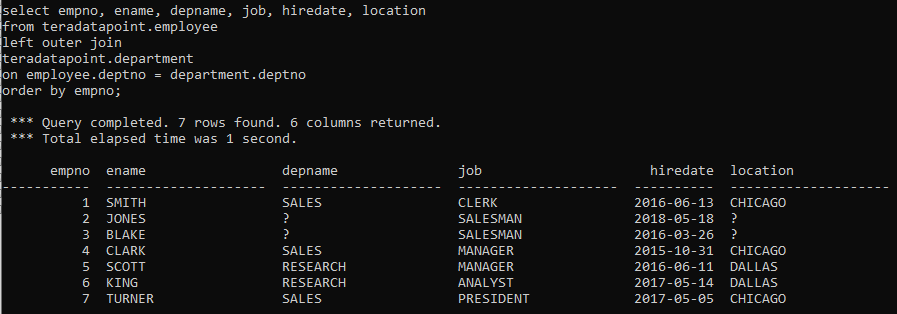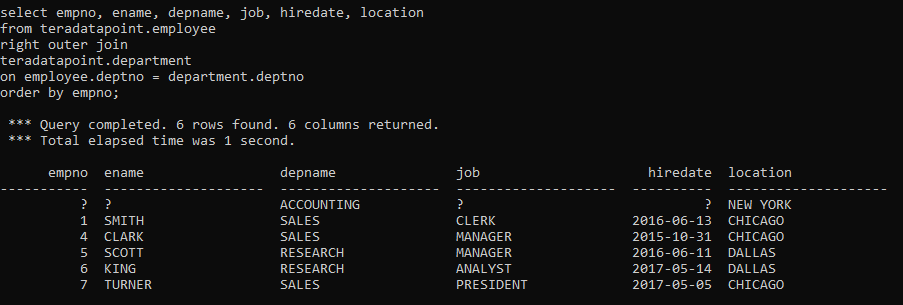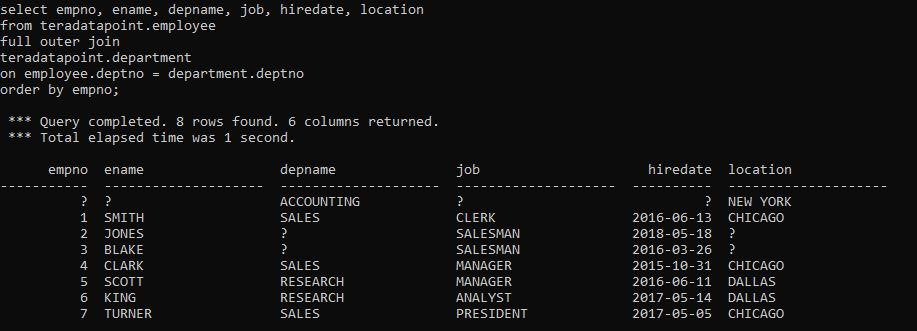Joins mean joining more than one table based on the common columns/values from these tables. Joins are helpful to get meaningful data for business queries.
Teradata supports different kinds of join as below.
- Inner Join.
- Left Outer Join.
- Right Outer Join.
- Full Outer Join.
- Self Join.
- Cross Join.
- Cartesian Production Join.
Inner Join
Inner Join combines records from more than one table and returns the values that exist in both the tables.
Inner Join Syntax
The syntax for Inner join is as follows.
Select column1, column2, ...., columnN from DatabaseName.TableName1 INNER JOIN Databasename.TableName2 on column1=column2 where condition;
Inner Join Example
Consider the following employee and department table.
Employee Table
| empno | ename | dob | job | mgr | hiredate | sal | deptno |
| 1 | SMITH | 24-02-1988 | CLERK | 7902 | 13-06-2016 | 800 | 20 |
| 2 | JONES | 10-07-1988 | SALESMAN | 7698 | 18-05-2018 | 1600 | 30 |
| 3 | BLAKE | 25-10-1990 | SALESMAN | 7698 | 26-03-2016 | 1250 | 30 |
| 4 | CLARK | 23-09-1991 | MANAGER | 7839 | 31-10-2015 | 2975 | 20 |
| 5 | SCOTT | 12-01-1992 | MANAGER | 7839 | 11-06-2016 | 2850 | 10 |
| 6 | KING | 05-08-1988 | ANALYST | 7839 | 14-05-2017 | 2450 | 10 |
| 7 | TURNER | 17-09-1988 | PRESIDENT | 7566 | 05-05-2017 | 3000 | 20 |
Department Table
| deptno | deptname | location |
| 10 | RESEARCH | DALLAS |
| 20 | SALES | CHICAGO |
| 40 | ACCOUNTING | NEW YORK |
The following query joins the employee table and department table on the common column deptno.
select empno, ename, depname, job, hiredate, location from teradatapoint.employee inner join teradatapoint.department on employee.deptno = department.deptno order by empno;
When the above query executed, it returns the following records.

Employee 2 and 3 are not included in the resultset as it does not have the matching records in the department table.
Outer Join
Outer join can be three types.
- Left Outer Join – returns all the records from the left table and only the matching records from the right table.
- Right Outer Join – returns all the records from the right table and only the matching records from the left table.
- Full Outer Join – It combines the results from both the left outer and right outer. It returns both matching and non-matching rows from the join tables.
Outer Join syntax
Select column1, column2, ..., columnN from DatabaseName.TableName1 LEFT OUTER JOIN/RIGHT OUTER JOIN/FULL OUTER JOIN DatabaseName.Tablename2 on column1=column2 where condition;
Outer Join Example
Left Outer Join
The following query returns all the records from the left table i.e. from the employee table even the matching records are not present in the right table i.e. department table.
select empno, ename, depname, job, hiredate, location from teradatapoint.employee left outer join teradatapoint.department on employee.deptno = department.deptno order by empno;
After executing the above query, it returns the below result.

Right Outer Join
The following query returns all the records from the right table i.e. department table even the matching records are not present in the left table i.e. from the employee table.
select empno, ename, depname, job, hiredate, location from teradatapoint.employee right outer join teradatapoint.department on employee.deptno = department.deptno order by empno;
After executing the above query, it returns the below result.

Full Outer Join
The following join query returns both the matching and non-matching records from the employee and department table.
select empno, ename, depname, job, hiredate, location from teradatapoint.employee full outer join teradatapoint.department on employee.deptno = department.deptno order by empno;
When the above query executes, it returns the following result.

CROSS JOIN
Cross join joins every row from the left table to every row from the right table.
Cross join Syntax
Following is the syntax of cross join.
Select column1, column2, ..., columnN from DatabaseName.TableName1 CROSS JOIN DatabaseName.Tablename2 where condition;
Cross Join Example
The following query is an example of the cross join in Teradata.
select empno, ename, depname, job, hiredate, location from teradatapoint.employee cross join teradatapoint.department where empno=1 order by empno;
When the above query is executed, it produces the following output. Employee 1 from the employee table is joined with every record from the department table.

